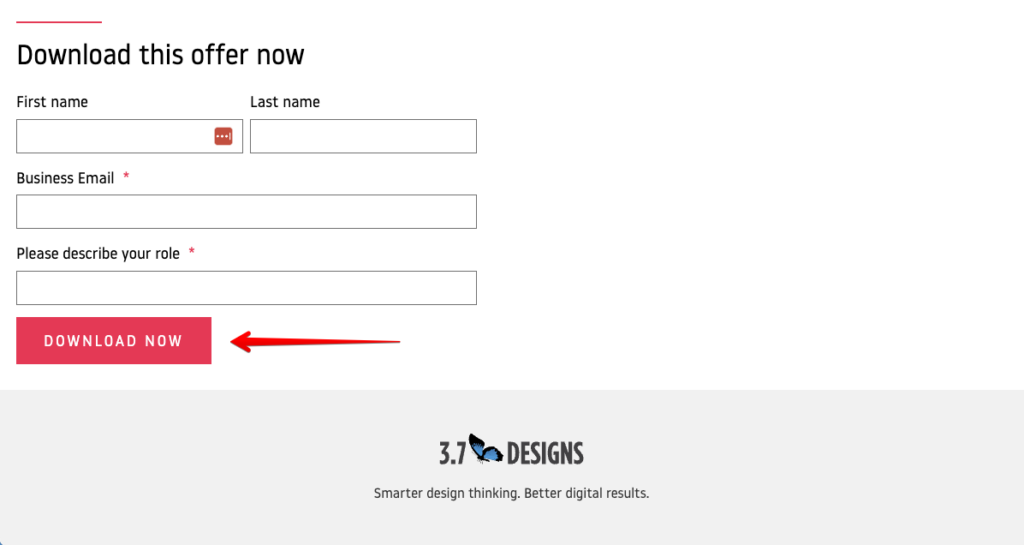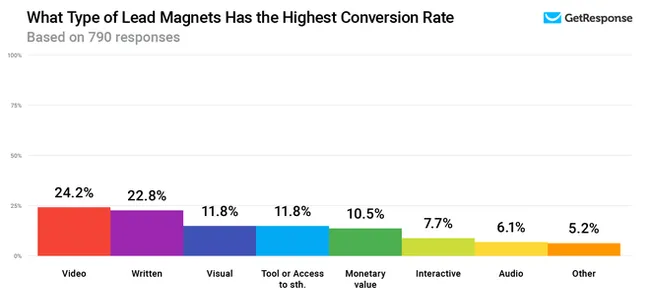How to Create Your First Lead Magnet

Only 20% of website visitors on average are ready to have a sales discussion. The remaining 80% must be nurtured until they get to that point. So how do you effectively nurture that 80% of your audience, build rapport, and nudge them toward a sale?
A lead magnet is one of the best tactics. Many brands see amazing results. Here’s everything you need to know about this medium and how to create your first lead magnet.
What Exactly is a Lead Magnet?
Just so we’re clear, a lead magnet is a piece of content, resource, or tool you provide to visitors in exchange for their contact information.
Common examples include:
- eBooks
- Whitepapers
- Webinars
- Training videos
- Product samples or trials
- Toolkits
By completing the signup for a call-to-action CTA, a visitor gets full access to the content, resource, or tool, and you gain valuable contact information and permission to follow up with them. On the 3.7 Designs website, for example, we offer visitors a lead generation guide called 5 Reasons Your Website Isn’t Generating Leads.

By clicking on the “Download Now” CTA, a visitor is taken to the landing page for an overview of the guide.

There we break down what the guide contains and how visitors can benefit from reading it. Those that are interested simply fill out the form and click the CTA below to download it.

At that point, they gain access to the guide, and we have their contact information.
Lead magnets are important because they allow your business to determine what might be of interest to visitors on your site and educate them on what you have to offer. Further, it establishes thought leadership and trust, allowing you to get your foot in the door with visitors. That way you can convert visitors into leads and ultimately leads into customers.
Because of their high value, include lead magnets in your marketing plan and goals. Plan time – and the proper budget – into your production cycle too.
How Much of an Impact Can a Lead Magnet Have?
Most marketers see significant results. One study found that 50% of brands that use lead magnets to encourage signups see higher conversion rates.
One of 3.7 Designs’ well-established clients features a powerful lead magnet on their site — an eBook that’s unlockable by providing contact information. And it’s been a huge source of lead flow with 30% of the client’s lead volume coming solely through the eBook. It’s proven to be an excellent piece of content that has not only benefited the client by generating a steady stream of leads, it’s benefited their website visitors as well.
In terms of lead magnets with the best conversion rates, a study by GetResponse found that it breaks down as follows:

The results, of course, can vary, but this should give you a good idea of what visitors are most receptive to.
How to Create Your First Lead Magnet Step-By-Step
1. Determine Your Target Audience
Again, the purpose of creating a lead magnet is to offer visitors something of value in exchange for their contact information. To accomplish this, you first need to know who you’re targeting. Typically, brands will have multiple audience segments with slightly different personas, which means it may take multiple lead magnets to appeal to everyone.
But when you create your first lead magnet, we suggest focusing on your highest priority target audience — the one that will likely translate into the most quality leads. You can always branch out later on and create additional lead magnets to reach the other audience segments, but initially, it’s best to zero in on high-priority visitors.
2. Identify What Your Target Audience Wants
Once you know who your target audience is, figure out how you can provide them with the most value. The target audience for our lead magnet, for instance, was businesses that want to generate more leads and increase their conversion rates. So, we created our guide specifically for these visitors, explaining the five biggest reasons why websites fail to generate leads and how to fix it.
3. Design and Produce Your Lead Magnet
Creating the lead magnet is the most time-consuming part of the process.
Here are your two main options:
- Use existing content from older blog posts to build a longer resource on a topic.
- Create your lead magnet content, resource, or tool from scratch.
Which approach is best? If you have a large archive that perfectly fits what your target audience is interested in, you could synthesize that to pull in a high volume of leads. But if you’re just starting out or have little existing content, you’ll likely need to start from the ground up.
In terms of the nuts and bolts of design and production, you can either hire a professional independent contractor to do it for you. Or, you can do it in-house which is fairly easy to do by using a platform like Canva. They offer a variety of templates along with built-in visuals to create a professional end product that can be downloaded via a PDF document.

4. Map Out the Journey Toward Lead Conversion
This consists of five components:
A. Blog post page – This will be focused on your lead magnet’s topic and helps generate visitor interest in selecting the CTA button that is placed within the content.
B. CTA – This is the button that appears in a blog post or content that a visitor selects to initiate the lead conversion process.
C. Landing page – This is the page a visitor lands on after clicking the CTA button and typically includes the signup form with the contact information you want to collect.
D. Thank you page – After a visitor completes the landing page form, they officially become a lead, and a new page opens that provides them with access to the promised lead magnet content, resource, or tool.
E. Kickback email – A few days after a lead has received their lead magnet content, you will send them a kickback follow-up message to start a conversation and continue engagement.
The final part of the process is to determine the frequency of updates you send to your new lead and schedule accordingly. At that point, you’ll engage with the lead and nurture them with the aim of ultimately converting them into a customer.
Advice From Personal Experience
To wrap up, here are a few key lessons we’ve learned by helping our clients generate leads through lead magnets. One is to put yourself in the shoes of your target audience and look at things from their point of view. Then, create content that answers the unique questions your target audience is seeking to resolve. That’s a vital precursor that will guide your subsequent efforts.
Another is to use the lead magnet in your favor. This medium is the perfect way to collect contact information, which is integral to effective lead nurturing. Having a field to gather contact information before a visitor can access your lead magnet (sometimes referred to as a gate) allows your sales team to seamlessly contact them later on and convert them into a sale. And because of the value they’re getting, most leads are happy to hand over their contact information.
Finally, don’t bombard the lead. As we mentioned earlier, a lead magnet can be incredibly effective for obtaining new business, if done correctly. That said, having a site that “attacks” visitors with pop-ups advertising lead magnets can do more harm than good and make it feel spammy. Instead, only offer solid lead magnets, and place them within appropriate areas of your site.
And when engaging with leads through email, be sure not to overdo it by barraging them with messages. Research by Campaign Monitor found that sending one email every two weeks is the “sweet spot” for getting results without burning leads out. However, you should always test your campaign to measure optimal frequency.
Generating Consistent Leads with a Lead Magnet
This medium has proven to get serious results, with some companies generating as much as 30% of their lead volume with it. Further, half of the companies that use lead magnets to encourage opt-ins see higher conversions. It just boils down to understanding your target audience, creating content that offers genuine value, and establishing a smooth journey toward lead conversion.
To learn more about how 3.7 Designs can help, reach out to us today.